Designing Effective “Power. Point Presentations” By: Satyajeet Singh


Designing Effective “PowerPoint Presentations” By: Satyajeet Singh [email protected]

Designing Effective PowerPoint Presentation Simple Consistent Clear Big Progressive Summary

Make It Big

Make it Big (Text) This is Arial 12 This is Arial 18 This is Arial 24 This is Arial 32 This is Arial 36 This is Arial 44

Make it Big (Text) This is Arial 12 This is Arial 18 This is Arial 24 This is Arial 32 This is Arial 36 This is Arial 44 Too Small

Make It Big (How to Estimate) Look at it from 2 metres away

Keep It Simple

Keep It Simple (Text) Too many colours Too Many Fonts and Styles The 6 x 7 rule No more than 6 lines per slide No more than 7 words per line

Keep It Simple (Text) Instructional Technology: A complex integrated process involving people, procedures, ideas, devices, and organization, for analyzing problems and devising, implementing, evaluating, and managing solutions to those problems in situations in which learning is purposive and controlled (HMRS 5th ed.) Too detailed !

Keep It Simple (Text) A process involving people, procedures & tools for solutions to problems in learning (HMRS 5th ed.) Instructional Technology: Much Simpler

Falling Leaves Observed Too detailed !
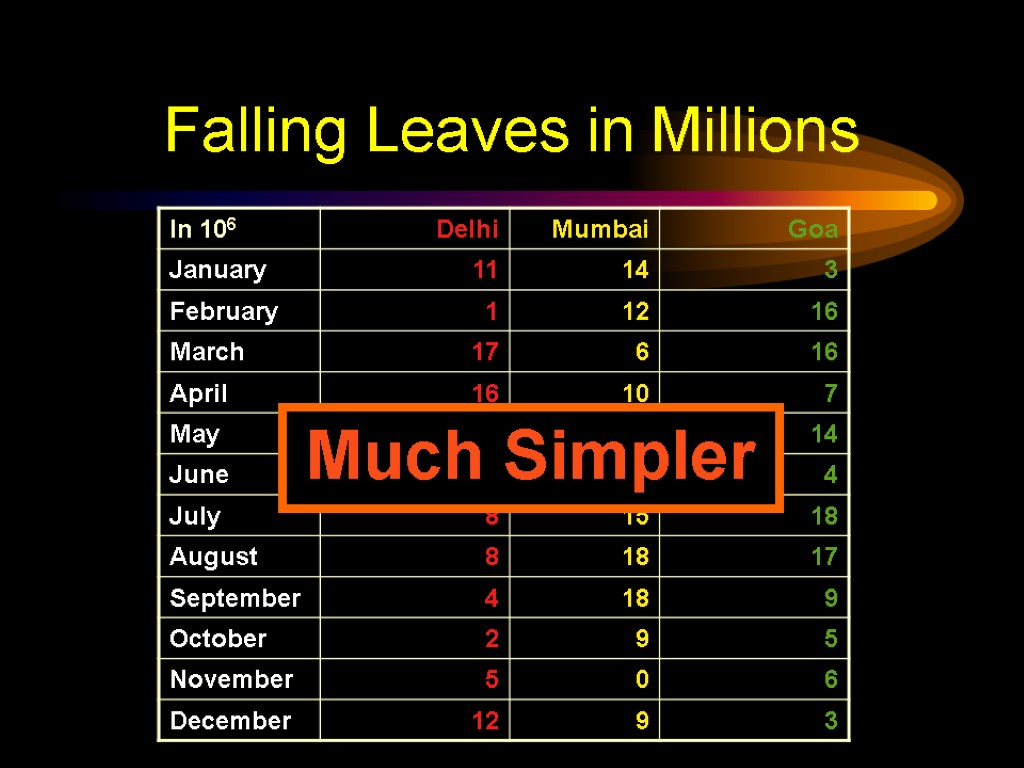
Falling Leaves in Millions Much Simpler

Falling Leaves Too detailed !

Falling Leaves Much Simpler
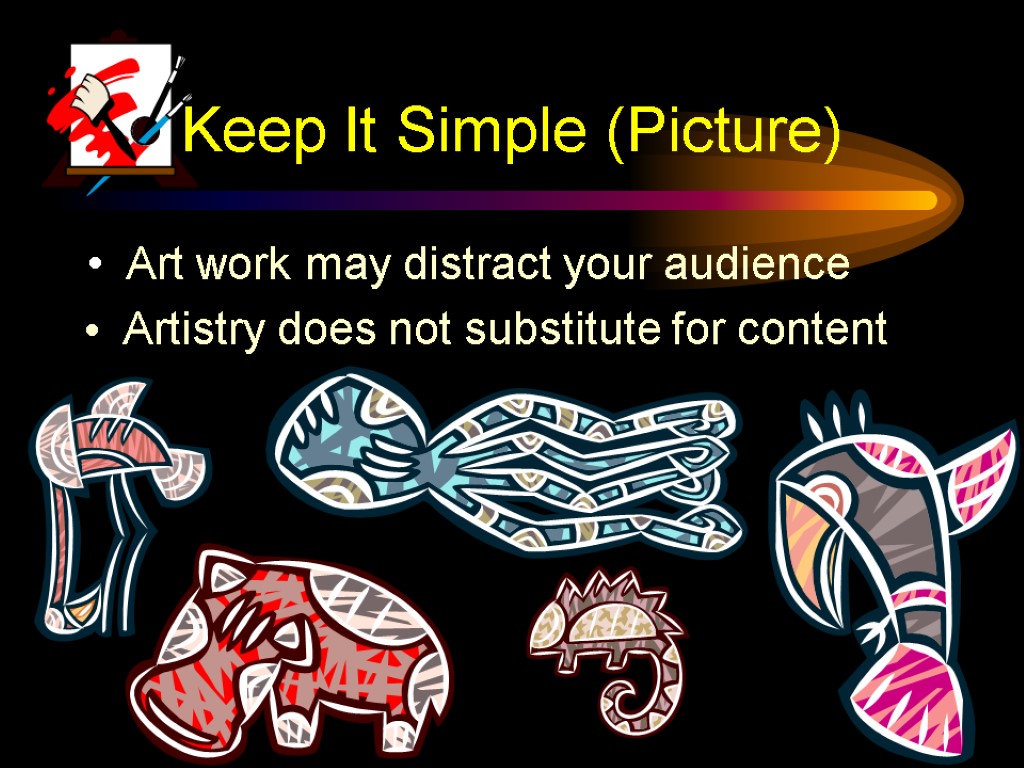
Keep It Simple (Picture) Art work may distract your audience Artistry does not substitute for content

Keep It Simple (Sound) Sound effects may distract too Use sound only when necessary

Keep It Simple (Transition) This transition is annoying, not enhancing "Appear" and "Disappear" are better

Keep It Simple (Animation) 2 m Too distracting !

Keep It Simple (Animation) Simple & to the point

Make It Clear

Make It Clear (Capitalisation) ALL CAPITAL LETTERS ARE DIFFICULT TO READ Upper and lower case letters are easier

Sanserif Z Serif Z Make It Clear (Fonts) busy clear

Serif fonts are difficult to read on screen Sanserif fonts are clearer Italics are difficult to read on screen Normal or bold fonts are clearer Underlines may signify hyperlinks Instead, use colours to emphasise Make It Clear (Fonts)

Make It Clear (Numbers) Use numbers for lists with sequence For example: How to put an elephant into a fridge? 1. Open the door of the fridge 2. Put the elephant in 3. Close the door

Make It Clear (Numbers) How to put a giraffe into a fridge? 1. Open the door of the fridge 2. Take out the elephant 3. Put the giraffe in 4. Close the door
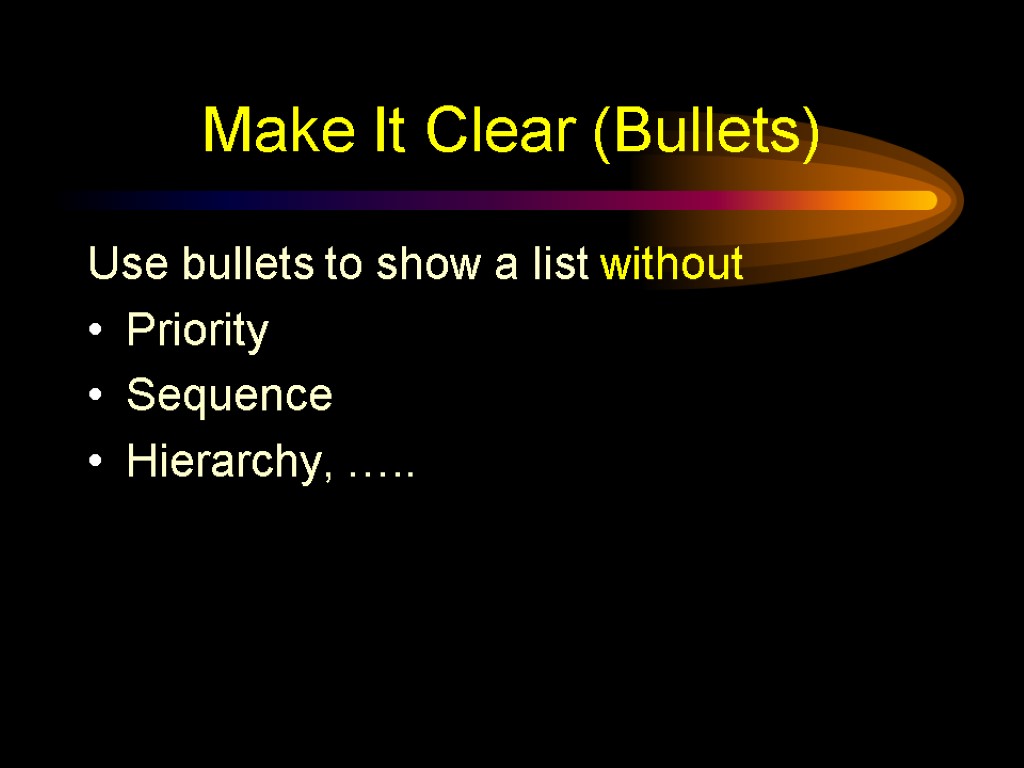
Make It Clear (Bullets) Use bullets to show a list without Priority Sequence Hierarchy, …..

Make It Clear (Colours) Use contrasting colours Light on dark vs dark on light Use complementary colours

Make It Clear (Contrast) Use contrasting colours Light on dark vs dark on light Use complementary colours
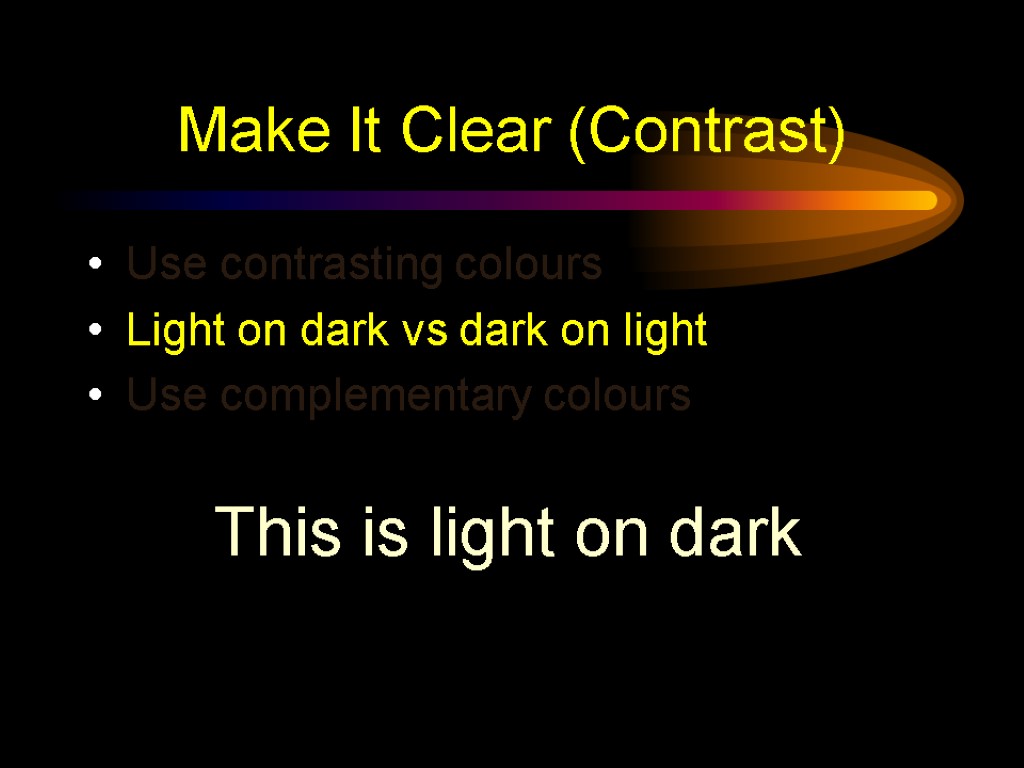
Make It Clear (Contrast) Use contrasting colours Light on dark vs dark on light Use complementary colours This is light on dark

Make It Clear (Contrast) Use contrasting colours Light on dark vs dark on light Use complementary colours This is dark on light

Make It Clear (Complement) Use contrasting colours Light on dark vs dark on light Use complementary colours These colours do not complement

Make It Clear (Complement) Use contrasting colours Light on dark vs dark on light Use complementary colours These colours complement

Make It Clear (Size) Size implies importance

Make It Clear (Size) Size implies importance

Make It Clear (Focal Points) Focal points direct attention

Make It Clear (Focal Points) Focal points direct attention

Be Progressive

Complexity of Interactions Mode of Instruction Individual Pair Group Direct Instruction Guided Inquiry Discovery Learning Individual Instructive Tools Individual Constructive Tools Social Constructive Tools Social Communicative Tools Informational Tools Types of Instructional Tools Too many in one go!

Complexity of Interactions Mode of Instruction Individual Pair Group Direct Instruction Guided Inquiry Discovery Learning Individual Instructive Tools Individual Constructive Tools Social Constructive Tools Social Communicative Tools Informational Tools Types of Instructional Tools Progressive & thus focused

Understanding Technology Floppy disk User interface CPU I/O Error Backup system Software Mouse Debugger Function key Main Storage Too many & not focused

Understanding Technology Floppy disk User interface CPU I/O Error Backup system Software Mouse Debugger Function key Main Storage Progressive & thus focused
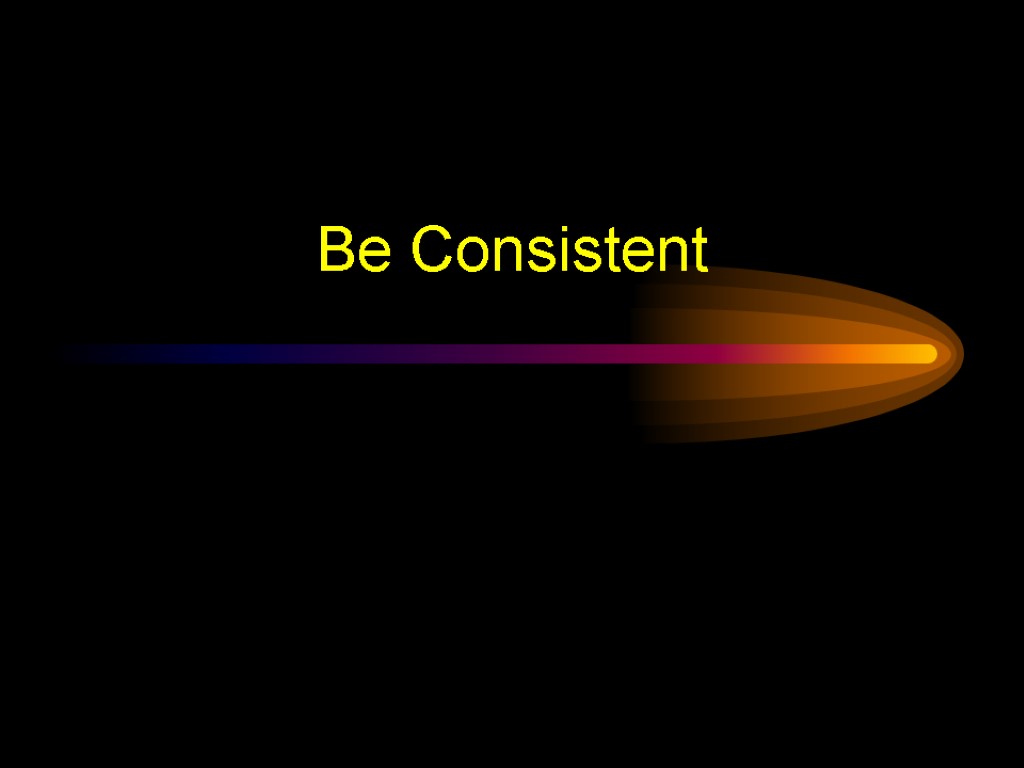
Be Consistent

Be Consistent Differences draw attention Differences may imply importance Use surprises to attract not distract

Be Consistent Differences draw attention Differences may imply importance Use surprises to attract not distract

Be Consistent Differences draw attention Differences may imply importance Use surprises to attract not distract

Be Consistent Differences draw attention Differences may imply importance Use surprises to attract not distract

Be Consistent Differences draw attention Differences may imply importance Use surprises to attract not distract

Be Consistent Differences draw attention Differences may imply importance Use surprises to attract not distract
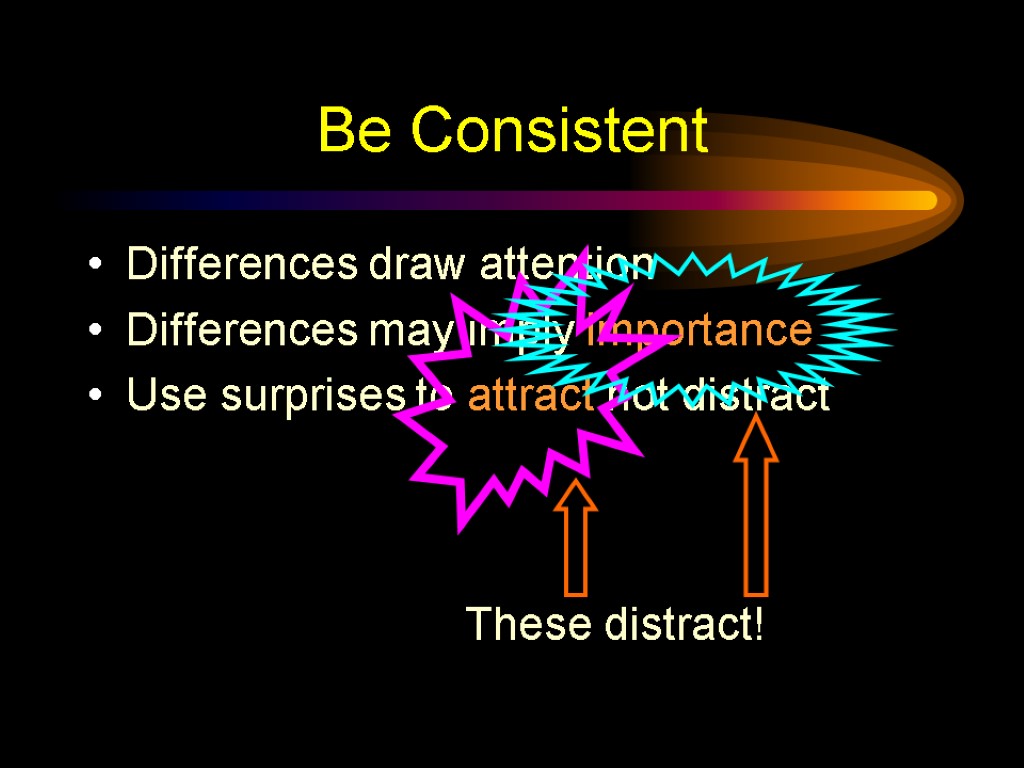
Be Consistent Differences draw attention Differences may imply importance Use surprises to attract not distract
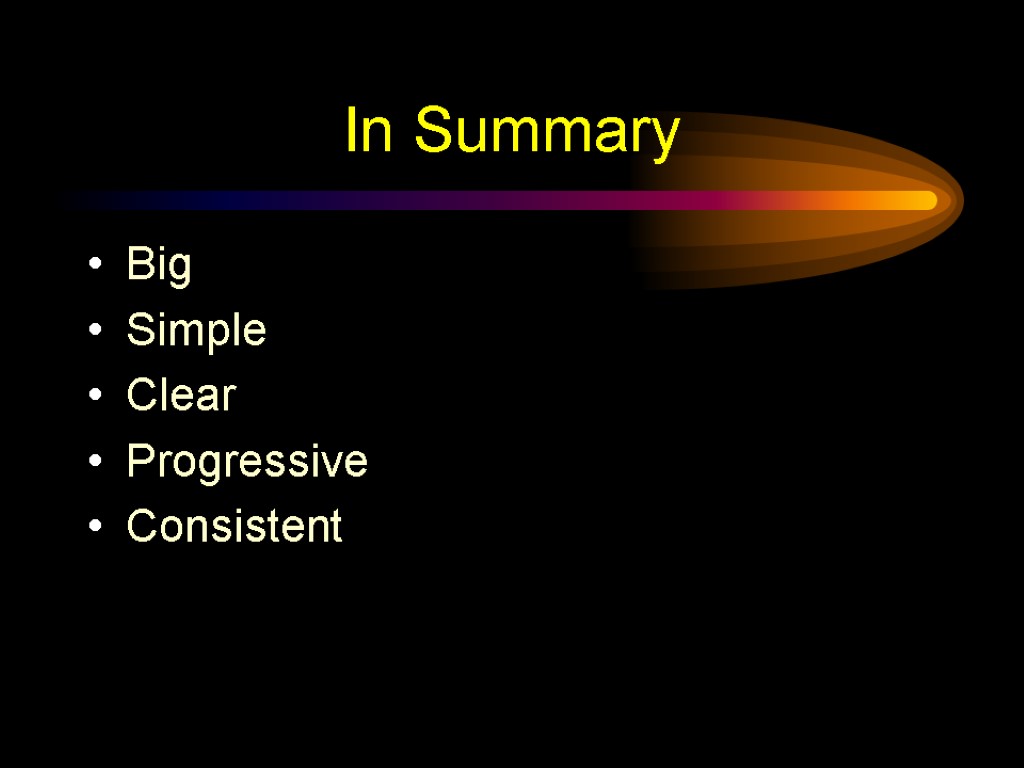
In Summary Big Simple Clear Progressive Consistent

Some Final Words

When Creating Text to support the communication Pictures to simplify complex concepts Animations for complex relationships Visuals to support, not to distract Sounds only when absolutely necessary Think about the people in the back of the room when creating slides

When Presenting Speak loudly and clearly with fluctuation Direct your words to all aspects of the room Maintain eye contact with your audience Ask questions of your audience (if applicable) Don’t read the slides word-for-word, use them for reference

Closing Remarks Practice your presentation before a neutral audience Ask for feedback Be particular about the time allotted for presentation Leave time for questions

Thank You !
how-to-make-effective-presentation.ppt
- Количество слайдов: 55

